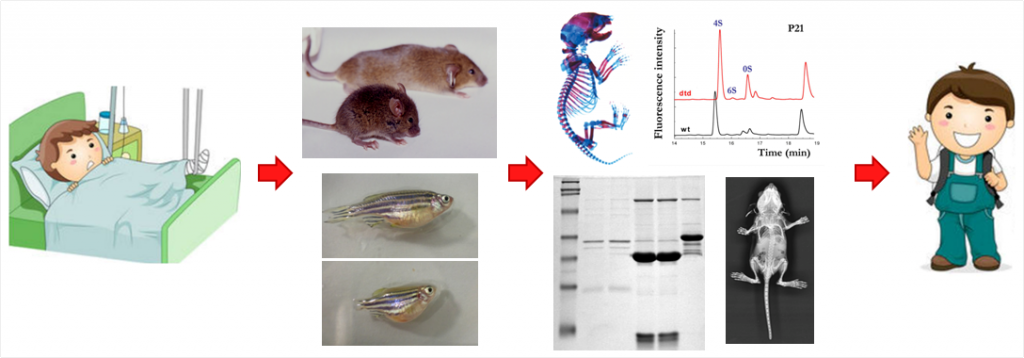Generation and deep phenotyping of animal models for heritable skeletal diseases to shed light on bone biology and find novel therapeutic approaches
Generation and deep phenotyping of animal models for heritable skeletal diseases to shed light on bone biology and find novel therapeutic approaches
Research Group: Prof. Antonella Forlino, Prof. Antonio Rossi, Dr. Roberta Besio

In the last decade several discoveries revealed that skeletal tissue is not only relevant as biomechanical support and protection for the body, but it has a fundamental role in regulating the metabolism of many different organs throughout its endocrine function. A proper skeletal homeostasis is necessary to guarantee bone function and a deep understanding of skeletal biology is necessary to face human disease diagnosis and treatment. The study of rare diseases has been one of the major tool to dissect novel skeletal functions providing a better picture of bone biology.
Our research group is mainly focused on the generation of knock-out and knock-in animal models (mice and zebrafish) for rare monogenic disease of cartilage and bone using traditional gene targeting technique based on embryonic stem cells homologous recombination as well as on the novel CRISPR/Cas gene-editing tool. The models are fully characterized from molecular, biochemical, morphological and histological point of view, they are used as tool to develop novel drug, and gene/cell therapy approaches. The PhD students will enter in a research group with long standing expertise in the field and many international collaborations. Projects on generation and characterization of novel disease models as well as the use of the ones already available for therapeutic purposes are available.
Recent Publications:
- Gioia R, Tonelli F, Ceppi I, Biggiogera M, Leikin S, Fisher S, Tenedini E, Yorgan TA, Schinke T, Tian K, Schwartz JM, Forte F, Wagener R, Villani S, Rossi A, Forlino A. The chaperone activity of 4PBA ameliorates the skeletal phenotype of Chihuahua, a zebrafish model for dominant osteogenesis imperfecta. Hum Mol Genet. 2017 May 5. doi: 10.1093/hmg/ddx171.
- Monti L, Paganini C, Lecci S, De Leonardis F, Hay E, Cohen-Solal M, Villani S, Superti-Furga A, Tenni R, Forlino A, Rossi A. N-acetylcysteine treatment ameliorates the skeletal phenotype of a mouse model of diastrophic dysplasia. Hum Mol Genet. 2015;24(19):5570-80.
- Bianchi L, Gagliardi A, Maruelli S, Besio R, Landi C, Gioia R, Kozloff KM, Khoury BM, Coucke PJ, Symoens S, Marini JC, Rossi A, Bini L, Forlino A. Altered cytoskeletal organization characterized lethal but not surviving Brtl+/- mice: insight on phenotypic variability in osteogenesis imperfecta. Hum Mol Genet. 2015; 24(21):6118-33.
